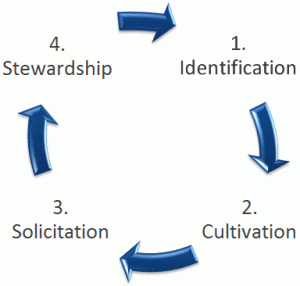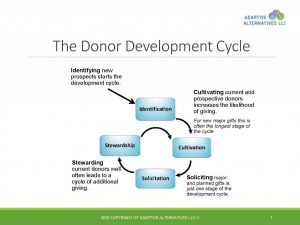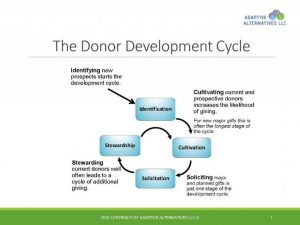Dear CARE Team members,
In this assignment we will be examining technical definitions and peer review each other’s work.
I have provided several different definitions of a term, donor development cycle, that is used regularly in my profession, Nonprofit Resource Development. The audience includes people with no prior resource development (fundraising) experience that are taking an introductory course on nonprofit management.
I look forward to receiving your feedback!
Sincerely,
Erica
Term: Donor Development Cycle
Parenthetical Definition:
Donor Development Cycle (stages in the fundraiser-donor relationship)
Sentence Definition:
The donor development cycle is a fundraising tool that defines the relationship between the donor and a nonprofit organization. It includes four major stages: identification, cultivation, solicitation and stewardship. The cycle continues until the donor ceases to contribute to the nonprofit. It is sometimes referred to as the donor lifecycle.
Two Visual Definitions:
The first visual definition illustrates the cycle when a new potential donor is identified. The nonprofit develops a relationship with the donor during “cultivation”. During “solicitation” the donor is asked to support the nonprofit by making a financial contribution; the donor makes the contribution. “Stewardship” includes follow-up after the funds are received and further relationship building. If the donor decides not to contribute, the donor re-enters the cultivation stage.

FIGURE 1 Donor Development Cycle
Source: https://www.amyeisenstein.com/getting-a-major-gift-moving-from-cultivation-to-the-ask/
This second visual definition shows the identification of new potential donors, in addition to the continuing cycle with recurring donors. Once a prospective donor makes a contribution, they move to the stewardship phase, and then on to cultivation. This visual gives explanations for each stage.

FIGURE 2 The Donor Development Cycle
Source: https://adaptivealternativesconsulting.com/2015/06/09/major-gift-fundraising-101-theres-no-magic-drawer-of-prospects/
Third Expanded Definition:
The Donor Development Cycle: Stages and Application
The donor development cycle defines the relationship between a donor and a nonprofit organization. This document breaks down the cycle into its parts, and uses a real-world example to show what might happen at each stage.
Our example: Tom is the Resource Development Director at his nonprofit organization, Holding Hands. Holding Hands provides tutoring services, in various subjects, for children coming from low socioeconomic conditions.

FIGURE 2 The Donor Development Cycle
Source: https://adaptivealternativesconsulting.com/2015/06/09/major-gift-fundraising-101-theres-no-magic-drawer-of-prospects/
The Four Stages:
1) Identification:
- Includes two main activities:
a) Understanding the non-profit’s needs: Which program requires funding? What are the objectives of the program? How does the program work? Which population does the program serve? What is the budget/financial need of the program?
b) Understanding which current donors or new potential donors might be interested in funding the program: thorough research must be conducted on the philanthropic interests of donors/foundations.
Example: Tom meets with the English as a Second Language (ESL) Program Coordinator; he learns that there are 200 children in the local community who could benefit from the service, but Holding Hands doesn’t have the funds to hire the additional tutors needed to expand the program. In order to hire 20 additional tutors for the school year, they need $10,000.
Tom remembers reading in the news about a private philanthropist, Ms. Jenny Wong, who donated a library to a local school. He thinks that she might be a good prospect for this program. He uses online resources and personal contacts within the nonprofit community to find out more about Ms. Wong and her philanthropic interests. Tom manages to get the contact details of her assistant, Elinor. Tom sends Elinor an introduction email. They schedule a time to speak on the phone.
2) Cultivation:
- This stage is about building a relationship with the donor and preparing the relationship for donation solicitation.
- Activities in this stage depend on the size of the organization, its resources for engaging their donors (manpower), and geographical location relative to the donor.
- At the minimum, the nonprofit professional in charge should be in contact with the donor either by email, telephone or with a face-to-face meeting.
- Efforts are made to ensure that the donor is up-to-date on current developments within the organization as a whole, and specifically for the program of interest.
Example: Following Elinor and Tom’s meeting, Elinor schedules a meeting between Tom and Ms. Wong. Tom prepares for the meeting by writing a 2-page document that introduces Holding Hands; the document includes: Holding Hands’ mission, programming, metrics (the number of children they help and how often, and how their grades have improved), the current challenge (lack of ESL tutors) and how they would like to solve the problem (hiring 20 additional tutors). The 2-page document is forwarded by email to Ms. Wong before the meeting.
Tom meets Ms. Wong at her office. He introduces Holding Hands, making sure to highlight points that he thinks would interest her. He also acknowledges Ms. Wong’s support and previous philanthropic contributions to the community. Tom invites Ms. Wong to visit their existing ESL program in action. After the meeting, Tom sends an email to Ms. Wong thanking her the for the meeting. Tom schedules a time for him and Ms. Wong to visit the Helping Hands ESL program.
At the scheduled time, Tom meets Ms. Wong and gives her a tour of the program. She speaks with the ESL Program Coordinator, a number of tutors, and asks one of the children if she is enjoying the program. Tom takes a photo of Ms. Wong during her visit. Following the visit, Tom sends a thank you email to Ms. Wong with the photo from the visit attached.
3) Solicitation
- This is the stage of “the ask”; the donor is asked to make a contribution.
- The amount of the requested donation should be appropriate; it should fit with the program’s budget and the donor’s ability to give.
- Solicitation can be done in several different ways and depends on the geographical proximity between the donor and the organization, and more importantly, how the donor prefers to be approached. Some ways to ask a donor are: direct mail, email, telephone, face-to-face visit, or a formal grant proposal to be submitted before a specific deadline.
- If a donor declines to contribute, further cultivation is needed, either for a lesser amount, for another program, or a later date.
- If the donor agrees to contribute the requested amount, quick follow-up is needed to receive the funds and to thank them.
Example: It is clear that the ESL program is a good fit for Ms. Wong’s interests and she has, in general, expressed a willingness to support it. Tom calls Ms. Wong to ask her to contribute $10,000 to the program. Ms. Wong agrees to the ask and says she will send a check in the mail.
4) Stewardship:
- This stage involves maintaining a good relationship with a donor so that they will become recurring donors and champions for the organization.
- Activities depend on the size of the organization and its resources, and the geographical proximity to the donor.
- At minimum, the donor should be kept updated on all organizational activities through eblasts and newsletters, and updated periodically either by email or telephone on the specific program that they contributed to.
- Efforts must be made so that the donor feels confident that their contributions are being used efficiently, and for the purpose that they were solicited for.
- The donor should feel happy about supporting the organization.
Example: Helping Hands receives Ms. Wong’s check. Tom immediately sends a thank you email and a handwritten thank you card. Tom notifies the ESL Program Coordinator; she hires 20 new tutors and the program expands to service another 200 children. Tom updates Ms. Wong and asks her if she would like to tour the expanded program and have her photo taken for a local newspaper to formally acknowledge the gift. Ms. Wong likes the idea.
Tom ensures that Ms. Wong is periodically updated on the ESL program and Holding Hand’s other programs through newsletters and eblasts. As an important donor for the organization, he also makes sure to personally update her periodically by email and by telephone. He also writes to congratulate her when he hears that she has received an Honorary PhD from a local university.
Tom will work to maintain the relationship with Ms. Wong and when another programming need arises, he will “cultivate” her again before asking for further contributions.
Fourth Expanded Definition:
Donor Development Cycle
Frequently Asked Questions
What is the Donor Development Cycle?
The donor development cycle is a fundraising tool that illustrates the relationship between a donor and a nonprofit organization. It is also known as the donor lifecycle.

FIGURE 1 Donor Development Cycle
Source: https://www.amyeisenstein.com/getting-a-major-gift-moving-from-cultivation-to-the-ask/
The cycle begins when a potential donor is identified. The nonprofit develops a relationship with the donor during “cultivation”. During “solicitation” the donor is asked to support the nonprofit by making a financial contribution; the donor makes the contribution. “Stewardship” includes the thanking the donor for their contribution and further relationship building.
What are the stages of the donor development cycle?
The donor development cycle includes four stages:
1) Identification: which programs require funding and who could potentially donate
This stage includes two main activities:
a) Understanding the nonprofit’s needs: Which program requires funding? What are the objectives of the program? How does the program work? Which population does the program serve? What is the budget/financial need of the program?
b) Understanding which current donors or new potential donors might be interested in funding the program: thorough research must be conducted on the philanthropic interests of donors/foundations.
2) Cultivation: building a relationship with the donor and preparation for “the ask”
Activities in this stage really depend on the size of the organization, its resources for engaging their donors (manpower), and geographical location relative to the donor. At minimum, the nonprofit professional in charge should be in contact with the donor either by email, telephone or a personal visit. Efforts are made to ensure that the donor is up-to-date on current developments within the organization as a whole, and specifically for the project of interest.
3) Solicitation: “the ask”
By this stage, the fundraiser has a relationship with the donor; the fundraiser should have an appropriate amount for “the ask” that fits with the program’s budget and the donor’s ability to give. There are different methods that can be used for solicitation; the method that is used depends on the geographical proximity to the donor and more importantly, how the donor prefers to be solicited. A donor may be solicited by email, telephone, or a face-to-face meeting. Some donors, especially foundations, require a formal grant proposal to be submitted before a specific deadline.
This stage also includes the donor’s response to the ask. If a donor is not prepared to contribute the requested amount, further cultivation is needed either for a lesser amount, a different program, or a later date. If the donor agrees to the ask, quick follow-up to receive the funds and to thank them is needed.
4) Stewardship: maintaining relationships with donors
At this stage, an organization will want to maintain a good relationship with the donor so that they will become recurring donors and champions for the organization. Stewardship activities depend on the size of the organization and its resources, and the geographical proximity to the donor. At minimum, the donor should be kept updated regularly on all organizational activities through eblasts and newsletters, and updated periodically either by email or telephone on the specific program that they contributed to.
Efforts must be made so that the donor feels confident that their contributions are being used efficiently, and for the purpose that they were solicited for. Donors should be happy about supporting the organization.
What happens if a prospective donor decides not to give?
A nonprofit professional should be prepared if a donor decides not to contribute. It is important to remain respectful and to ask why the donor decided not to contribute. Further discussions with the donor may reveal that the ask amount was too high or that the donor is over-committed (made too many philanthropic contributions in the current year). In some cases, the program tied to the ask doesn’t really appeal to the donor, but another program might. The donor re-enters the cultivation phase, they are kept updated and the relationship building continues until they are again solicited.
It’s also possible that for, whatever reason, the donor doesn’t identify with the mission of the organization or their interests have moved on (to other organizations doing other types of work). They should be considered lapsed donors (previously donated to the organization but stopped) or potential donors in the future to be re-identified for new programs in the future.
Sources:
- CASE: Council for Advancement and Support of Education. Fundraising Fundamentals, Section 7.1. Retrieved from: www.case.org
- Eisenstein, Amy. (2013, April). Getting a Major Gift: Moving From Cultivation to the Ask. Retrieved from: www.amyeisenstein.com/
- Freeth, Stephanie. (2015, June 9). Major Gift Fundraising 101: There’s no magic drawer of prospects. Retrieved from: www.adaptivealternativesconsulting.com
- Qgiv. Donor Stewardship: Create Lifelong Donors in 10 Steps. Retrieved from: www.qgiv.com
Leave a Reply